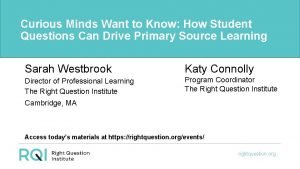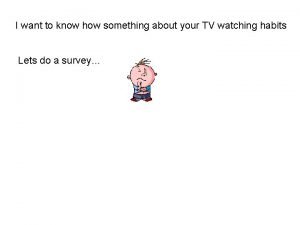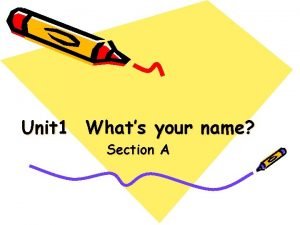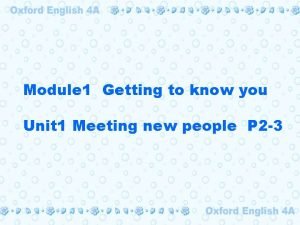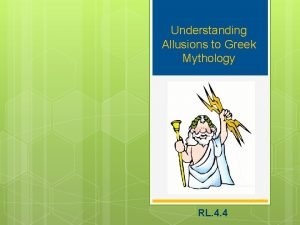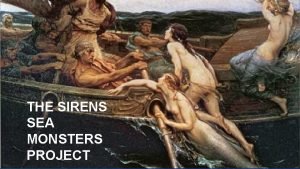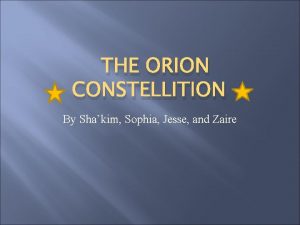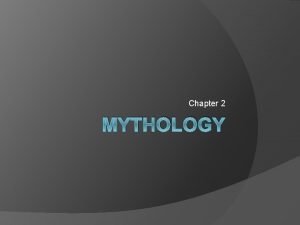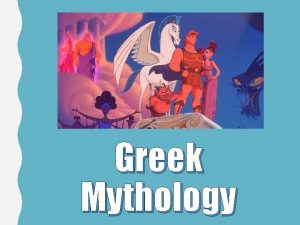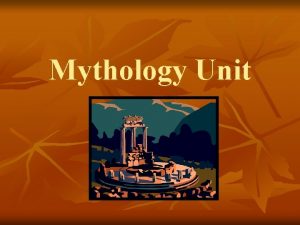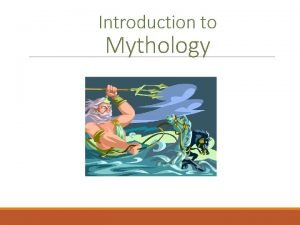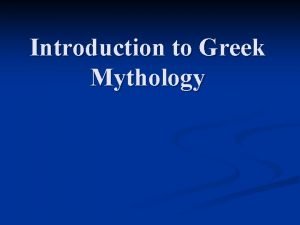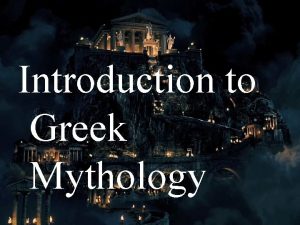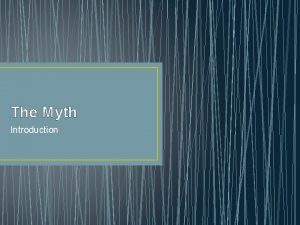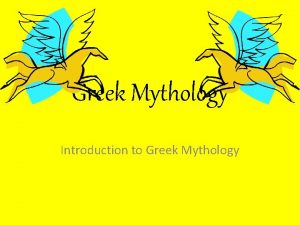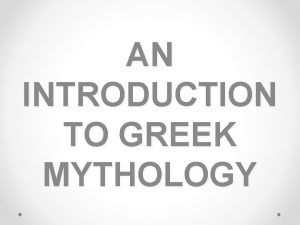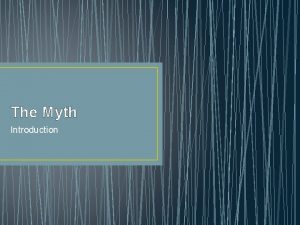Unit I Mythology Introduction I want to know



















- Slides: 19

Unit I: Mythology Introduction “I want to know what were the steps by which men passed from barbarism to civilization. ” -Voltaire

Distinction • Myths are stories within themselves. • Mythology is the actual study of those myths. • Word comes from the Greek word mythos meaning “story” • It later came to mean “falsehood” (Logos = Logic) • Myths are anonymous.

Myth Definition • Myth: a traditional or legendary story, usually concerning some being or hero or event, with or without a determinable basis of fact or a natural explanation, especially one that is concerned with deities or demigods and explains some practice, rite, or phenomenon of nature.

Purpose of Myth • One of the chief reasons that myths came into being was because people couldn’t provide scientific explanations for the world around them. • One person’s “myth” is another person’s religion.

Significance • Every Culture has some sort of myth. • Myths explain how that particular culture viewed everything from daily life to the afterlife • Even the United States has its own particular brand of myths (Tall Tales/ Folklore/ Superheroes).

Similarities between Myths • Myths don’t just pop up out of the ground. They are often borrowed from older sources and then molded and remade into new myths. • This is why so many myths are similar between cultures.

Mind and Society • Two of biggest proponents of myths were Sigmund Freud and Carl Jung (pronounced “Young”) • Freud would use myths to examine the human mind and our unconscious feelings (Oedipus Complex) • Jung would take a different approach.

Carl Jung’s Theory • Jung believed that “myths draw their mysterious power from the fact that principle characters in them embody primitive archetypes which have exercised great influence over the human psyche. ” • "Myths are first and foremost psychic phenomena that reveal the nature of the soul. “ –Carl Jung

The Collective Unconscious • Where Freud believed in the personal unconscious…Jung believed in a “Collective Unconscious. ” • Personal Unconscious = at one time was part of the individual’s conscious state, but for one reason or another was forgotten or repressed with the passage of time. • Collective Unconscious = “a psychic system of a collective, universal and impersonal nature that is identical in all individuals. ” • This inherent psychic system consists of preexisting forms, or as Jung call it, archetypes.

• Personal unconscious is one person (ex. Repressed/Painful memories). • Collective unconscious is society (ex. the way a society thinks or feels).

Archetype Explained • Jung believed that our collective unconsciousness was organized into basic patterns and symbols that he called archetypes. • Our dreams, art, religion, and perhaps most important, our myths are all among the ways that humans have expressed those archetypes.

Common Archetypes • • Hero Trickster Shadow Quest Mentor Shapeshifter Guardians

Otto Rank • Austrian Psychoanalyst • Colleague of Freud and Jung. • Agreed with Jung’s theory of the collective unconscious. • Established Archetype framework for myths. • Especially myths of heroes.

Archetypical Framework for Mythical Heroes • Found the same patterns over and over again within myths and within our lives. – 1. ) The hero descents from noble, powerful parents. – 2. ) Parents have previous difficulties. – 3. ) There is a prophesy about the hero. – 4. ) The hero is exposed in a river, in a box, in the wilderness, etc. – 5. ) The hero is saved by animals or peasants. – 6. ) The hero is raised by lowly parents. – 7. ) Hero returns to his first parents. – 8. ) The first parents are punished in some way. – 9. ) The hero gains recognition from his father/gods. – 10. ) The hero is honored.

Joseph Campbell • Although these items are not all present in every myth, elements can be found in all myths. • Joseph Campbell not only agreed with Jung and Rank, but continued to establish what he called the “monomyth” or Hero’s Journey.

Monomyth



A window to Understanding • Myths are used to understand not only the culture and society in which they were created, but the individuals who learned and lived by the myths.
 Curious minds want to know
Curious minds want to know Drench my soul as mercy and grace unfolded
Drench my soul as mercy and grace unfolded Curious minds want to know
Curious minds want to know Curious minds want to know
Curious minds want to know If you want to know me by noemia de sousa
If you want to know me by noemia de sousa I want to know something about
I want to know something about Whats your name bob
Whats your name bob Know history know self
Know history know self Do deep generative models know what they don’t know?
Do deep generative models know what they don’t know? The one who reigns forever he is a friend of mine
The one who reigns forever he is a friend of mine Unit 5 grammar future time answers
Unit 5 grammar future time answers Go con ing
Go con ing Unit 5 what do you want to do
Unit 5 what do you want to do Unit 6 review questions
Unit 6 review questions Unit 1 getting to know you ответы
Unit 1 getting to know you ответы Greek mythology hierarchy
Greek mythology hierarchy Tulpar
Tulpar Greek mythology
Greek mythology Sirens greek mythology facts
Sirens greek mythology facts Orion meaning
Orion meaning



